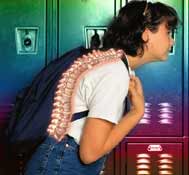September is here and the kids are either back in school or will be soon. How are you going to make sure they have a happy and healthy school year? That they will have the best capacity to stay healthy, focus fully and perform at their best? That they have the proper fitting backpack and are wearing it correctly?
The ability to perform at your best, maintain focused attention and stay happy and healthy are all dependant upon your lifestyle. To achieve your highest level of performance and function you must provide yourself with the proper nutrients, be well rested, get exercise, have effective tools for managing stress and most importantly you must have a nerve system that functioning properly.
This month we will discuss proper nutrition and backpacks. Next month we will discuss getting enough sleep and a healthy nerve system.
Proper Nutrition
It is always a challenge to make sure your child is eating  healthy and nutritious foods especially when they are not with you. Educating them about the importance of healthy food choices is a vital first step toward preparing your child to make healthy choices when he/she is on their own. The following are tips for how to make your child’s breakfast, lunch and dinner healthier and more enjoyable.
healthy and nutritious foods especially when they are not with you. Educating them about the importance of healthy food choices is a vital first step toward preparing your child to make healthy choices when he/she is on their own. The following are tips for how to make your child’s breakfast, lunch and dinner healthier and more enjoyable.
Breakfast
Each morning your child should get some protein, fats and  carbohydrates so that they have short term, mid-range and long lasting sources of energy to last them until lunchtime. Incorporating some vegetables and fruit is an important step for setting the tone for the rest of the day. Recent research out of Northwestern University demonstrates that the more you incorporate vegetables and fruits into your diet, the more you perceive a level of control over what you eat and your health.
carbohydrates so that they have short term, mid-range and long lasting sources of energy to last them until lunchtime. Incorporating some vegetables and fruit is an important step for setting the tone for the rest of the day. Recent research out of Northwestern University demonstrates that the more you incorporate vegetables and fruits into your diet, the more you perceive a level of control over what you eat and your health.
I also strongly encourage starting the day with a high quality Multivitamin, Vitamin D, Fish Oils and a Probiotic (see our November 2011 Newsletter for more information on these vital nutrients.)
Lunch
If you pack a lunch for your child, packing healthy foods which may include fresh hormone and antibiotic free meats, whole grain bread, vegetables and fruit maybe even with a humus dip and water (not juice) are good choices.
and antibiotic free meats, whole grain bread, vegetables and fruit maybe even with a humus dip and water (not juice) are good choices.
Keeping things different and interesting is tough so talking with your child in advance and making a list of the things he/she will eat is a great idea because thinking of things last minute, when you are trying to get that lunch together fast can be a challenge.
If your child likes to eat the school lunch, make sure to review the menu with them picking and choosing what items they should have each day. This is vital because if you don’t, most of the time you will not like what they have chosen.
On a side note, I applaud the new superintendent in our District 96 schools. She has changed food vendor to one that will be providing organic and hopefully healthier choices. Our kids are worth it.
Dinner
 We all know what a healthy meal looks like, it is just a matter of MAKING the time to prepare and eat it.
We all know what a healthy meal looks like, it is just a matter of MAKING the time to prepare and eat it.
Leading by example is key. If you want your kids to eat a nice salad, eat their vegetables, drink water, eat slowly and share the details of their day with you, YOU MSUT DO THE SAME.
For more tips on healthy eating and meal planning see our September 2011 Newsletter – Eating Healthy.
Backpacks
Heavy and improperly worn backpacks can negatively impact the health of your child. School-age children SHOULD NOT HAVE NECK AND BACK PAIN. If they do have these pains, there is something wrong and it should be corrected before it causes a lifelong problem (could this have been a contributor to your current aches and pains?).
pains, there is something wrong and it should be corrected before it causes a lifelong problem (could this have been a contributor to your current aches and pains?).
Backpacks have emerged as an escalating health and safety issue. In fact, the majority of school-age children carry backpack loads that are too heavy for their developing bodies. If children are carrying too much weight on their backs and shoulders they may stretch or strain their muscles causing injury and curvature of the spine.
- Studies have shown that long exposures to heavy backpacks can cause spinal pain that becomes chronic in nature and affects ALL activities of daily living.
- Heavy or improperly worn backpacks promote abnormal posture development and can possibly cause or accelerate structural spinal abnormalities such as scoliosis.
- The Consumer Product Safety Commission estimates that in 1999, approximately 6,174 emergency room visits were a result of spinal injuries stemming from heavy backpacks and in the year 2000, the use of heavy book bags and carriers resulted in more than 6,500 injuries. THIS IS A PROBLEM.
This increase in back pain amongst children is not surprising when you consider the disproportionate amount of weight they carry in their backpacks (often slung over just one shoulder).
- According to a recent study, the average child carries a backpack that would be the equivalent of a 39-pound burden for a 176-pound man or a 29-pound load for a 132-pound woman. Of those children carrying heavy backpacks to school, 60% had experienced back pain as a result.
- Other studies have shown that slinging backpacks over one shoulder can exacerbate the curvature of the spine in scoliosis patients.
What Can We Do?
- Healthy children get injured less than unhealthy children – Proper diet, supplementation, exercise, restorative rest & a Healthy Nerve System will give your child his/her best defense against heavy backpacks.
- Make sure your child’s backpack weighs no more than 10% of his/her body weight.
- Use both shoulder straps. Lugging the backpack around by one strap can cause the disproportionate shift of weight to one side, leading to neck and back muscle spasm, pain and possible alteration of spinal curvature.
- Wide, padded straps are very important. Non-padded straps are uncomfortable and can dig into your child’s shoulders.
- The backpack should be worn higher up on the back between the shoulder blades.
- The backpack should never hang more than four inches below the waistline. A backpack that hangs too low increases the weight on the shoulders pulling the child backward and causing him/her to lean forward when walking.
- Observe your child’s posture. If the child leans forward while walking, takes shorter strides while walking or uses his/her hands to protect the shoulders from the straps, it is an indication the backpack is too heavy.
- A backpack with individualized compartments helps in positioning the contents most effectively. Make sure that pointy objects are packed away from the area that will rest on your child’s back.
- Bigger is not better. The more room there is in a backpack, the more your child will carry – and the heavier the backpack will be.
If the backpack is too heavy:
- Take out anything that is not ABSOLUTELY needed
- Instead of taking all notebooks home carry only what is needed for that evening in 1 homework folder.
- Closely look at what your child is carrying and then talk to your child’s teacher. Ask if your child could leave the heaviest books at school, and bring home only lighter hand-out materials or workbooks…
Note: Proper Nerve System and Spinal Health are VITAL for children to avoid early onset of damage and degeneration caused by the chemical, physical and mental emotional stressors in their lives (including heavy backpack). Schedule a Nerve System and Spinal Health evaluation with a Pediatric Chiropractor for your children TODAY!
Our expertise will improve your family’s Quality of Life!
Call Stern Chiropractic to schedule your family’s health evaluation TODAY!
I hope you have enjoyed our newsletter. If you know someone this may help, please share it. This small act of sharing can have profound effects for generations to come.
Like Stern Chiropractic on Facebook and see health and wellness articles posted on a regular basis.
